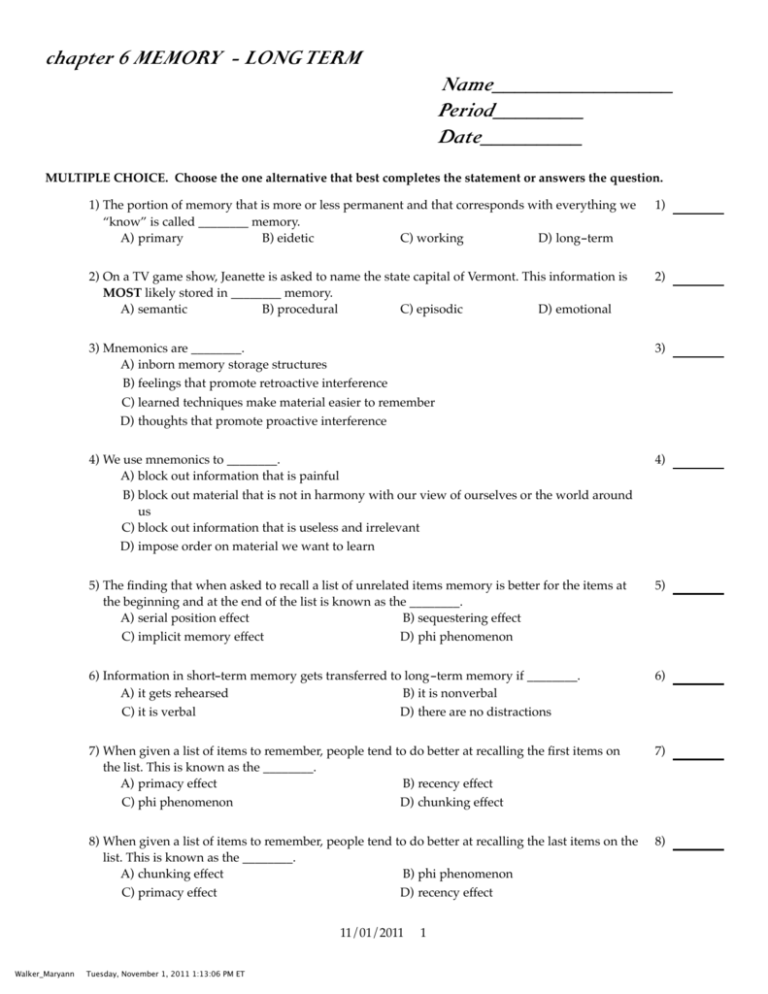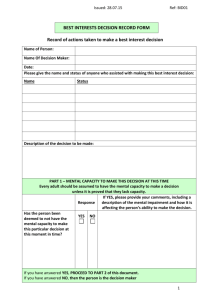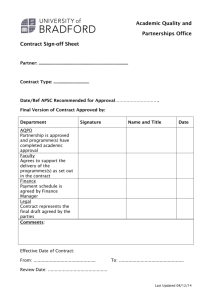Long-Term Memory Quiz: Psychology Assessment
advertisement

chapter 6 MEMORY - LONG TERM Name________________ Period________ Date_________ MULTIPLE CHOICE. Choose the one alternative that best completes the statement or answers the question. 1) The portion of memory that is more or less permanent and that corresponds with everything we “know” is called ________ memory. A) primary B) eidetic C) working D) long-term 1) 2) On a TV game show, Jeanette is asked to name the state capital of Vermont. This information is MOST likely stored in ________ memory. A) semantic B) procedural C) episodic D) emotional 2) 3) Mnemonics are ________. A) inborn memory storage structures B) feelings that promote retroactive interference C) learned techniques make material easier to remember D) thoughts that promote proactive interference 3) 4) We use mnemonics to ________. A) block out information that is painful B) block out material that is not in harmony with our view of ourselves or the world around us C) block out information that is useless and irrelevant D) impose order on material we want to learn 4) 5) The finding that when asked to recall a list of unrelated items memory is better for the items at the beginning and at the end of the list is known as the ________. A) serial position effect B) sequestering effect C) implicit memory effect D) phi phenomenon 5) 6) Information in short-term memory gets transferred to long-term memory if ________. A) it gets rehearsed B) it is nonverbal C) it is verbal D) there are no distractions 6) 7) When given a list of items to remember, people tend to do better at recalling the first items on the list. This is known as the ________. A) primacy effect B) recency effect C) phi phenomenon D) chunking effect 7) 8) When given a list of items to remember, people tend to do better at recalling the last items on the list. This is known as the ________. A) chunking effect B) phi phenomenon C) primacy effect D) recency effect 8) 11/01/2011 Walker_Maryann Tuesday, November 1, 2011 1:13:06 PM ET 1 9) Which of the following memory systems can hold the most information? A) long-term memory B) short-term memory C) they all hold equal amounts of information D) the sensory registers 10) Long-term memory can store ________. A) vast amounts of information but only for a few seconds at a time B) vast amounts of information for many years C) only a few items for no more than a few seconds at a time D) only a few items but for many years 10) 11) The type of memory that is most like an encyclopedia or a dictionary is ________ memory. A) episodic B) semantic C) emotional D) procedural 11) 12) The meaning of the word “civilization” would be stored in ________. A) eidetic memory B) long-term memory C) the sensory registers D) short-term memory 12) 13) George imagines a lawyer's office as having a large mahogany desk, with leather chairs, surrounded by large bookshelves full of law books and framed diplomas and law degrees hanging from wood-paneled walls. His vision of a lawyer's office is a(n) ________. A) schema B) mnemonic C) archetype D) icon 13) 14) Suddenly thinking of a friend's name without knowing why is an example of ________ memory. A) explicit B) eidetic C) implicit D) procedural 14) 15) When Rip Van Winkle returns to his native village after 20 years of sleeping in the mountains, he goes immediately to the location of his former house and asks for his wife and children by name. The kind of memory he is exhibiting by remembering his home's location and the names of his wife and children is ________ memory. A) procedural B) emotional C) episodic D) semantic 15) 16) Your memories of personal experiences such as what you wore to work yesterday or what you ate for breakfast this morning are stored in ________. A) episodic memory B) procedural memory C) emotional memory D) semantic memory 16) 17) Remembering a telephone number because it contains the numbers of the year in which you were born is an example of the use of ________. A) chunking B) elaborative rehearsal C) rote rehearsal D) eidetic imagery 17) 2 Walker_Maryann 9) Tuesday, November 1, 2011 1:13:06 PM ET 18) A mental representation of an event, an object, a situation, a person, a process, or a relationship that is stored in memory and that leads you to expect your experience to be organized in certain ways is a(n) ________. A) archetype B) concept C) schema D) icon 18) 19) Elaborative rehearsal involves ________. A) relating new information to something you already know B) repeating something as well as physically acting out the concept you are trying to learn C) simply repeating something over and over again D) organizing basic information into meaningful units 19) 20) The linking of new information in short-term memory to familiar material stored in long- term memory is called ________. A) elaborative rehearsal B) rote rehearsal C) chunking D) overlearning 20) 21) Material is transferred from short-term to long-term memory through ________. A) categorizing B) rote rehearsal C) chunking D) elaborative rehearsal 21) 22) Rote rehearsal is ________. A) useful for retaining information in both short-term and long-term memory B) useful for retaining information in short-term, but not long-term, memory C) not useful for retaining information in either short-term or long-term memory D) useful for retaining information in long-term, but not short-term, memory 22) 23) The standard method of storing away largely meaningless material such as phone numbers, birth dates, and people's names is through the use of ________. A) rote rehearsal B) deep processing C) elaborative rehearsal D) cognitive schemas 23) 24) In one study, adults who had graduated from high school more than 40 years earlier were able to recognize about ________ percent of their classmates. A) 100 B) 50 C) 25 D) 75 24) 25) Which of the following statements is true? A) Material stored by meaning can usually be retrieved word-for-word. B) Sentences are stored verbatim in long-term memory. C) Material is usually stored in long-term memory according to meaning. D) Both deep and surface structure are aspects of rote rehearsal. 25) 26) The concept of a house would be stored in ________. A) long-term memory B) short-term memory C) eidetic memory D) the sensory registers 26) 3 Walker_Maryann Tuesday, November 1, 2011 1:13:06 PM ET 27) In the famous case of H. M., after having part of his brain removed, he could ________. A) form new implicit, but not explicit, memories B) form new explicit, but not implicit, memories C) form new implicit and explicit memories D) no longer form new implicit or explicit memories 27) 28) Which of the following statements is NOT true? A) Mnemonic techniques are methods of encoding material that help us to remember. B) Rote memorization is just as effective as mnemonic techniques for getting information into long-term memory. C) A mnemonic technique may be based on rhyme. D) Mnemonic techniques may involve visualization. 28) 29) A set of beliefs of expectations about something based on past experience is a(n) ________. A) mnemonic B) schema C) stereotype D) archetype 29) 30) Which of the following statements is true? A) The more an item is repeated, the more improvement will be shown in later recall. B) Rote rehearsal is not effective in learning items such as ABCs. C) Extensive rote rehearsal is as efficient as elaborative rehearsal for permanent memory. D) Repetition without any intent to learn does not enhance long-term memory. 30) 31) Most information in long-term memory is coded ________. A) by meaning B) by rote rehearsal C) by surface structure D) with few cross-indexes 31) TRUE/FALSE. Write 'T' if the statement is true and 'F' if the statement is false. 32) Everything we know is stored in long-term memory. 32) 33) The capacity of long-term memory is virtually limitless. 33) 34) Some of the simplest mnemonic techniques are rhymes and jingles. 34) 35) General knowledge of facts and information is stored in semantic memory. 35) 36) To keep information in short-term memory, we only need to rehearse it one or two times. 36) 37) Elaborative rehearsal is crucial to future recall. 37) 38) Sometimes we know things but that knowledge is unconscious. 38) 39) Most information in long-term memory is coded in terms of the intensity of the stimuli. 39) 4 Walker_Maryann Tuesday, November 1, 2011 1:13:06 PM ET Answer Key Testname: CH 6 MEMORY LT ONLINE QUIZ 1) D Page Ref: 193 2) A Page Ref: 197 3) C Page Ref: 195 4) D Page Ref: 195 5) A Page Ref: 194 6) A Page Ref: 195 7) A Page Ref: 194 8) D Page Ref: 194 9) A Page Ref: 193 10) B Page Ref: 193-194 11) B Page Ref: 197 12) B Page Ref: 194 13) A Page Ref: 195-196 14) C Page Ref: 198 15) C Page Ref: 196 16) A Page Ref: 196 17) B Page Ref: 195 18) C Page Ref: 195-196 19) A Page Ref: 195 20) A Page Ref: 195 21) D Page Ref: 195 22) A Page Ref: 194 23) A Page Ref: 194 11/01/2011 Walker_Maryann Tuesday, November 1, 2011 1:13:06 PM ET 5 Answer Key Testname: CH 6 MEMORY LT ONLINE QUIZ 24) D Page Ref: 193 25) C Page Ref: 194 26) A Page Ref: 194 27) A Page Ref: 198 28) B Page Ref: 195 29) B Page Ref: 195-196 30) D Page Ref: 195 31) A Page Ref: 194 32) TRUE Page Ref: 193 33) TRUE Page Ref: 193 34) TRUE Page Ref: 195 35) TRUE Page Ref: 197 36) FALSE Page Ref: 194 37) TRUE Page Ref: 195 38) TRUE Page Ref: 198 39) FALSE Page Ref: 194 6 Walker_Maryann Tuesday, November 1, 2011 1:13:06 PM ET




